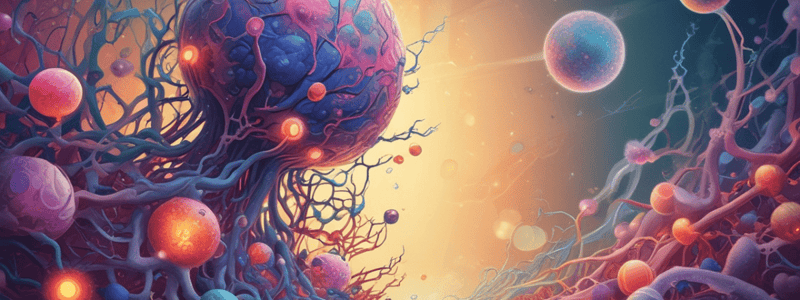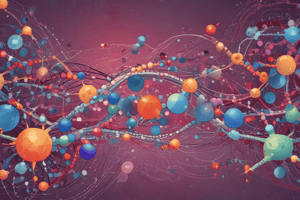Podcast
Questions and Answers
What is the fundamental principle that lies at the heart of carcinogenesis?
What is the fundamental principle that lies at the heart of carcinogenesis?
- Non-lethal genetic damage (correct)
- Accumulation of mutations over time
- Viral infections only
- Environmental agents only
What type of mutations confer a growth advantage on cells?
What type of mutations confer a growth advantage on cells?
- Driver mutations (correct)
- Passenger mutations
- Proto-oncogenes
- Oncoproteins
What is a characteristic of normal cells in terms of growth factors?
What is a characteristic of normal cells in terms of growth factors?
- Uncontrolled proliferation
- Independence from growth factors
- Dependence on growth factors (correct)
- Sensitivity to apoptosis
What happens to normal somatic cells after a limited number of divisions?
What happens to normal somatic cells after a limited number of divisions?
What is a characteristic of oncogenes?
What is a characteristic of oncogenes?
What is a hallmark of cancer?
What is a hallmark of cancer?
What is a mechanism of self-sufficiency in growth signals in cancer cells?
What is a mechanism of self-sufficiency in growth signals in cancer cells?
What is the result of the accumulation of mutations over time in a cell?
What is the result of the accumulation of mutations over time in a cell?
What is the function of tumor suppressor genes?
What is the function of tumor suppressor genes?
What is the term for the normal genes that promote cell proliferation and differentiation?
What is the term for the normal genes that promote cell proliferation and differentiation?
What is the result of mutations in cyclin genes?
What is the result of mutations in cyclin genes?
What is the function of the RAS gene?
What is the function of the RAS gene?
What is the result of overexpressing nuclear transcription factors?
What is the result of overexpressing nuclear transcription factors?
What is the result of mutations in the Her2/NEU receptor?
What is the result of mutations in the Her2/NEU receptor?
What is the result of the BCR-ABL fusion gene?
What is the result of the BCR-ABL fusion gene?
What is the function of the MYC gene?
What is the function of the MYC gene?
What is the characteristic of tumor suppressor genes in terms of carcinogenesis?
What is the characteristic of tumor suppressor genes in terms of carcinogenesis?
What is the result of inheriting one defective copy of a tumor suppressor gene and losing the second one through somatic mutation?
What is the result of inheriting one defective copy of a tumor suppressor gene and losing the second one through somatic mutation?
What is the role of the RB gene in retinoblastoma?
What is the role of the RB gene in retinoblastoma?
Why does familial transmission of retinoblastoma follow an autosomal dominant inheritance pattern?
Why does familial transmission of retinoblastoma follow an autosomal dominant inheritance pattern?
What is the role of the TP53 gene?
What is the role of the TP53 gene?
What is the result of activating the DNA damage checkpoint?
What is the result of activating the DNA damage checkpoint?
What is the role of the APC gene?
What is the role of the APC gene?
What is the result of P53 inducing DNA repair genes?
What is the result of P53 inducing DNA repair genes?
Flashcards are hidden until you start studying
Study Notes
The Molecular Basis of Cancer
- Oncogenesis is the formation or induction of tumors, involving mutant forms of normal genes called proto-oncogenes, which code for oncoproteins.
- Genetic damage, acquired through environmental agents or inherited, is the fundamental principle of carcinogenesis, resulting in a single progenitor cell that has incurred genetic damage and undergoes clonal expansion.
- Carcinogenesis involves the accumulation of mutations over time, as well as one-off catastrophic events.
Mutations in Cancer
- Driver mutations confer a growth advantage on cells and are located in cancer genes.
- Passenger mutations do not confer a growth advantage.
Normal Cellular Processes
- Dependence on growth factors and cell/tissue-specific signals is a normal characteristic of cells.
- Loss of these signals leads to apoptosis.
- Anchorage-dependent proliferation requires interaction with the extracellular matrix (ECM) through transmembrane proteins (integrins).
- Contact inhibition occurs when cells are in contact with each other, inhibiting proliferation and movement.
- Normal somatic cells have a limited number of divisions before entering senescence.
The Hallmarks of Cancer
- Sustaining proliferative signaling: oncogenes promote uncontrolled cell proliferation through mechanisms such as stimulating independent growth factor secretion, mutated growth factor receptors, and over-expressed nuclear transcription factors.
Oncogenes and Tumor Suppressor Genes
- Oncogenes are mutated forms of proto-oncogenes that promote cancer cell growth autonomously.
- Oncoproteins (products of oncogenes) promote uncontrolled cell proliferation.
- Mechanisms of self-sufficiency in growth signals include:
- Stimulus-independent secretion of growth factors
- Mutation/over-expression of growth factor receptors
- Mutation in genes encoding signaling proteins from receptor to nucleus
- Over-expression of nuclear transcription factors promoting cell cycle
- Mutations in cyclin genes resulting in uncontrolled cell proliferation
- Tumor suppressor genes encode proteins that inhibit cellular proliferation by regulating the cell cycle.
- Mutation in tumor suppressor genes leads to uninhibited cell proliferation.
Tumor Suppressor Genes
- Both copies of the gene must be lost for carcinogenesis to occur (autosomal recessive).
- In cases with familial predisposition, affected persons inherit one defective copy of a tumor suppressor gene and lose the second one through somatic mutation.
- Examples of tumor suppressor genes include:
- RB gene in retinoblastoma
- P53 in human cancers
- APC in Adenomatous polyposis coli
Cell Cycle Regulation
- The RB gene prepares for mitosis and controls the cell cycle.
- DNA damage checkpoint arrests the cell cycle, allowing for DNA repair or apoptosis.
- P53 is a tumor suppressor gene that maintains the integrity of the genome and senses DNA damage, assisting in DNA repair by arresting the cell cycle and inducing DNA repair genes.
Studying That Suits You
Use AI to generate personalized quizzes and flashcards to suit your learning preferences.




